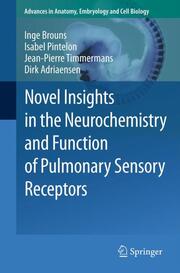Detailansicht
Novel Insights in the Neurochemistry and Function of Pulmonary Sensory Receptors
Advances in Anatomy, Embryology and Cell Biology 211
Brouns, Inge/Pintelon, Isabel/Timmermans, Jean-Pierre et al
ISBN/EAN: 9783642227714
Umbreit-Nr.: 1476562
Sprache:
Englisch
Umfang: xii, 118 S., 2 s/w Illustr., 21 farbige Illustr.,
Format in cm:
Einband:
kartoniertes Buch
Erschienen am 06.10.2011
Auflage: 1/2011
- Zusatztext
- With the advances of immunohistochemistry in combination with confocal microscopy, airway sensory receptor end-organs can now be examined and evaluated objectively. Based on their 'neurochemical coding', morphology, location and origin, three sensory receptor end organs are currently morphologically well-characterised: smooth muscle-associated airway receptors (SMARs), neuroepithelial bodies (NEBs) and visceral pleura receptors (VPRs). The present information on the functional morphological and neurochemical characteristics of these sensory receptors, leads to important conclusions about their (possible) function.
- Kurztext
- Airway sensory nerve terminals are tailored to detect changes in the physical and chemical environment, thereby supplying local pulmonary information to the central nervous system. Since most intrapulmonary nerve terminals arise from fibres travelling in the vagal nerve, the classification of 'sensory airway receptors' is largely based on their action potential characteristics, electrophysiologically registered from the vagal nerve. However, the architecture of airways and lungs makes it nearly impossible to functionally locate the exact nerve terminals that are responsible for the transduction of a particular intrapulmonary stimulus.In this monograph we focus on three sensory receptor end organs in lungs that are currently morphologically well-characterised: smooth muscle-associated airway receptors (SMARs), neuroepithelial bodies (NEBs) and visceral pleura receptors (VPRs). Unravelling the main functional morphological and neurochemical characteristics of these sensory receptors using advanced immunohistochemistry and confocal microscopy has already allowed us to draw important conclusions about their potential function(s).The current development of ex vivo lung models for the selective identification of SMARs, NEBs and VPRs using vital staining will certainly facilitate direct physiological studies of these morphologically well-characterised airway receptors, since these models allow direct live studies of their functional properties.
- Autorenportrait
- InhaltsangabeSensory nerve terminals in intrapulmonary airways and lungs.- Electrophysiologicalls identified airway receptors: main characteristics.- Morphology and location of electrophysiologically identified sensory airway receptors.- The neurochemical coding of airway afferents.- Morphologically identified sensory receptor end-organs in the airways, lungs and visceral pleura.- In situ functional imaging of sensory receptors in lung models.- Concluding remarks and future prospects.- Subject index
